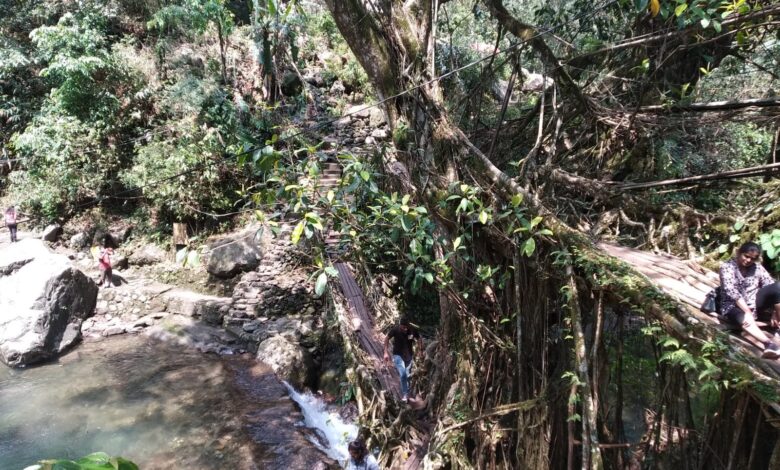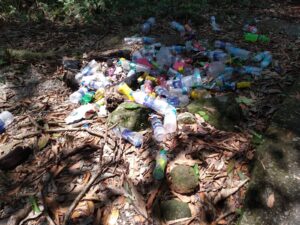Need to bridge economic gap at Nongriat
Pandemic shows how a balance between sustainable farming & tourism is necessary in the double-decker root bridge village

A poster inside Santina Homestay says, “Not On Map”. The tagline is visible in a few more places in Nongriat village. However, the hamlet under Shella-Bholaganj block has been on the tourism map for a few years now and the footfall there on April 21 was testimony to it.
Nongriat, which has earned fame for its double-decker living root bridge, has seen a boom in tourism despite the difficult terrain that it is located on. The pandemic put a brake on tourism for two years but it gradually regained steam from the second part of last year. Now, over 200 visitors come to the place each day which is less than half of the pre-pandemic number.
The trek to Nongriat starts from Tyrna village in Cherrapunjee. The walk to the ‘root bridge village’ is as breath-taking as it is difficult. And yet, it is attracting tourists from all age groups. In fact, tourism has become the main source of livelihood in the primarily agrarian village. The backlash of this economic change was felt during the pandemic when tourism became nil.
Villagers’ plight
The last two years were a struggle for the villagers at Nongriat. With no tourism and complete market shutdown, villagers’ income came to a naught.
Santina Wahlang, who runs a homestay, said many houses did not have enough food and had to depend on forest produce.
“We would get ration from the government once a month and it was not enough. We had to walk all the way to Cherrapunjee market (about 16 km) to get whatever we found,” she informed.
Nongriat has over 30 households and villagers mostly grow cash crops like bay leaf, pepper, betel nuts and betel leaves, which they sell in the local markets. Vegetables are rarely grown. But the pandemic forced a few to grow vegetables and sell in the village.
When asked, Elbin Warshiong, a 43-year-old farmer, said while government aid remained elusive, the villagers shared food in dire straits.
Surviving in the obscure hamlet
The pandemic was another reason that made the villagers vulnerable. The problems, said Warshiong, are aplenty and are aggravated by the remoteness of the hamlet.
Not everyone in the village earns a living from tourism, and for them, agriculture remains the primary source of income. These villagers have to collect the produce from farmlands in the community forest surrounding the village and sell them in Cherrapunjee. That remains a humongous task for them considering the difficult terrain.
“We carry at least 50 kg of betel leaves to the market that fetch us only about Rs 150. So, one trip is not always enough. The villagers here are poor and hard-working but they do not get the proper price for their work,” said Warshiong.
Besides betel leaves, broom sticks are also taken to the market. The journey starts around 7 am and it takes about 2 hours to reach Tyrna carrying the load.
Hilarious Synrem, the headman of the village, runs a humble homestay with his wife Santina. The wood and cement structure with two rooms has been built by him and there was no government support, he informed.
“We have not received any tourism scheme. Other government schemes too are elusive,” Synrem added.
Government help

Surviving in the remote village is difficult and government support for both agriculture and tourism becomes imperative.
A ropeway was constructed in Mawlakiat village a decade ago for transporting agricultural produce and other essential goods. However, the ropeway is defunct for over six years now. Warshiong said the ropeway, if restarted, would help villagers transport the farm produce.
“To carry the items takes us 2-3 hours but with the ropeway, it took us only 15 minutes. So, if it is repaired and manned regularly, it will not only save time but a lot of effort,” observed Warshiong.
According to Synrem, those who are running homestays and eateries for tourists in the village should get government schemes so that better facilities can be developed. He informed that only one person has received fund for building a homestay.
Synrem was referring to Serene Homestay that is run by Byron Nongbri. Unlike other homestays, Nongbri’s accommodation is an RCC structure that stands as an eyesore near the double-decker root bridge.
When asked, Nongbri was discreet about the funding and said he built it over the years. “I had to invest a lot of money to build this. The pandemic was a jolt and there was no income. However, tourists are back and I hope the business runs well,” he added.
Managing tourism
Though tourism has given an alternate income option to the villagers in Nongriat, it has also brought distress along with it. On the trekking way from Tyrna to Nongriat, one cannot miss the profusion of plastic bottles and other garbage left behind by tourists. Empty bottles of liquor can also be spotted on the way to Rainbow Falls. Even the Sacred Grove near the village is littered with garbage.
When asked, Synrem said the villagers run a cleaning drive once every month.
The recent Unesco temporary listing of Meghalaya root bridges has also helped in piquing the interest of tourists from all over the country. However, not many are keen on the Unesco tag. Nongbri said he was aware of the development but he does not want the permanent listing.
“This will only affect my business because the listing will call for no structures in the vicinity of the root bridges. I invested a lot of money in building the homestay and I cannot demolish it now,” said Nongbri.
Sunday Monitor asked the Tourism Department and the Meghalaya Basin Development Authority about the government support extended to the village but there was no response.
What the village immediately needs is a plan for tourism management and basic training to villagers in doing so. The local tourist guides can also be trained to make aware of waste management. They, in turn, can tell visitors to abstain from littering. The village dorbar should impose penalty for littering.
Agriculture is the main source of livelihood for most of the villagers who are unaware of buyer-seller platforms. There has to be an awareness on the various government schemes for farmers and a sustainable plan to reach the produce to the market. For instance, the ropeway, if restarted, can solve the transportation problem to a great extent. The state government’s iTeams can have a remote branch at Mawlakiat to collect the farm produce.
As Nongriat turns into a popular tourist destination, care should be taken so that the traditional way of living and sustaining is not disturbed by the tryst with the outside world.





